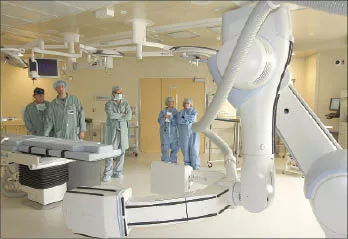Sacred Heart converts surgery suite for 'hybrid' procedures
$3.4 million project enables doctors to do CT imaging during invasive surgery

Providence Sacred Heart Medical Center & Children's Hospital has spent $3.4 million to convert one of its surgical suites to accommodate an innovative combination of imaging equipment and an operating table, enabling surgeons to perform what are called "hybrid" procedures.
Sacred Heart says it's one of just 10 hospitals in the U.S. and the only one in Washington state to equip a surgical suite with the equipment, which combines a surgical table with a computed tomography (CT) scanner and is made by German manufacturing giant Siemens AG.
Having a surgical suite equipped in such fashion will enable doctors to perform advanced vascular and cardiac procedures, and to do both invasive surgery and imaging-supported noninvasive procedures on a patient at the same time, says Marilyn Bash, Sacred Heart's director of preoperative services.
The new equipment, called Artis Zeego, cost $1.9 million, and the hospital spent another about $1.5 million expanding and remodeling the surgical suite to accommodate it, Bash says.
Sacred Heart also is in the process of hiring up to eight additional employees, including seven surgical technicians and nurses and possibly an additional radiology technician, to augment its surgical team in its use of the new equipment, Bash says.
The hospital expects to begin using the converted suite early next month.
The new hybrid suite includes 1,200 square feet of floor space, about twice as much as most of the hospital's other 33 operating rooms, Bash says. The new space was taken from what had been a back hallway.
The Artis Zeego consists of an adjustable-height operating table and robotic C-Arm imaging machine. The C-Arm can be moved in many directions and turned to be positioned at any angle, eliminating the need to move a patient during surgery, Bash says.
It can provide continuous CT imaging during a procedure, or be retracted to allow a standard operation to be conducted, she says.
Dr. Stephen Murray, a vascular surgeon here, says that previously, the only option for doing imaging during an invasive surgery was to bring into a surgical room portable imaging equipment. Such equipment, he says, frequently overheats and doesn't provide as clear an image as the Artis Zeego can, especially for very heavy patients. Also, the Artis Zeego exposes the patient to less radiation than portable imaging devices do, he says.
Conversely, if a patient who is undergoing minimally invasive procedures in a catheterization lab at the hospital, such as for placement of a heart stent, suddenly needs invasive surgery, he or she currently needs to be moved into a surgical suite for such care, Bash says. With the Artis Zeego, the stent procedure could be don e in the new suite, allowing a more invasive procedure to be done if necessary without moving the patient, she says.
Murray says vascular surgeons are ready to begin performing procedures in the new suite, including aortic stent grafts and hybrid vascular procedures, in which a patient undergoes an invasive procedure at the same time that a less invasive one, such as an angioplasty or stent procedure, is being done. They'll also be able to do three-dimensional arteriograms, Murray says.
They haven't been able to do that previously.
Interventional pediatric cardiologist Dr. Carl Garabedian says cardiologists and surgeons now will be able to work together to perform procedures on infants, such as placing pulmonary stents and repairing a hole in the bottom chamber of the heart.
Another procedure that likely will be performed in the new suite is called a hybrid Norwood, Garabedian says. He says that procedure is a surgical repair for babies who are born with no left ventricle or aorta, a condition called hypoplastic left heart syndrome.
Using the new suite, surgeons now will be able to do a modified version of the procedure on newborns, using temporary measures including a stent to alter the blood flow in the heart, Garabedian says. That will allow doctors to wait until an infant is six months old to do the full procedure, in which they reroute pulmonary arteries to create an aorta and left ventricle, thereby improving the infant's chances of survival.
Three or four of the full-scale procedures are performed at Sacred Heart each year, Garabedian says.
Related Articles

_c.webp?t=1763626051)
_web.webp?t=1764835652)

